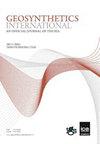刚性微粒-EPS 微珠复合材料的变形特性和蠕变行为
IF 3.3
2区 工程技术
Q2 ENGINEERING, GEOLOGICAL
引用次数: 0
摘要
通过进行两组大尺寸土力计实验,系统地研究了玻璃微珠(代表刚性颗粒)和发泡聚苯乙烯微珠(代表可变形颗粒)混合物在加载-卸载过程中的压缩行为,包括逐步加载和一步加载两种情况。在加载-卸载循环过程中的每一步,都测量了纯刚性样品和硬软颗粒混合物的空隙率(e)和静止时的侧向土压力系数(K0)。为了考虑蠕变效应,在卸载之前,将最后加载步骤的覆土压力保持在样本上 24 小时。结果表明,在给定的覆土压力下,随着软颗粒加入到纯刚性骨料中,e 值和 K0 值都会降低。此外,对于纯刚性样品和刚性-软性颗粒混合物,随着覆土压力的增加,e 值减小,而 K0 值增大。此外,由于在恒定加载步骤中的蠕变行为,两种样本的 K0 都会随时间推移而减小;与软硬颗粒混合物相比,纯刚性集料的蠕变现象更为明显。最后,我们使用一个成熟的蠕变模型来模拟纯刚性样品和刚柔颗粒复合材料的蠕变行为。本文章由计算机程序翻译,如有差异,请以英文原文为准。
Deformation characteristics and creep behaviour of rigid particulates-EPS beads composites
The compression behaviour of the mixture of glass beads (representing rigid particles) and EPS beads (representing deformable particles) during the loading-unloading process is systematically examined through performing two sets of large-size oedometer experiments, including incremental step-by-step and one-step loading scenarios. At each step during the loading-unloading cycle, the void ratio (e) and the at-rest coefficient of lateral earth pressure (K0) are measured for pure rigid samples and rigid-soft particle mixtures. To consider the creep effect, the overburden pressure at the final loading step is maintained on the sample for 24 hours prior to unloading. The results show that at a given overburden pressure, with the addition of soft particles to the pure rigid aggregates, the values of e and K0 decrease. Additionally, for both pure rigid samples and rigid-soft particle mixtures, with increasing the overburden pressure, e decreases whereas K0 augments. Moreover, due to the creep behaviour during the constant loading step, K0 decreases over time for both samples; the phenomenon which is observed to be more pronounced for pure rigid aggregates compared to rigid-soft particle mixtures. Finally, a well-established creep model is used to simulate the creep behaviour of pure rigid samples and rigid-soft particle composites.
求助全文
通过发布文献求助,成功后即可免费获取论文全文。
去求助
来源期刊

Geosynthetics International
ENGINEERING, GEOLOGICAL-GEOSCIENCES, MULTIDISCIPLINARY
CiteScore
6.90
自引率
20.00%
发文量
91
审稿时长
>12 weeks
期刊介绍:
An online only, rapid publication journal, Geosynthetics International – an official journal of the International Geosynthetics Society (IGS) – publishes the best information on current geosynthetics technology in research, design innovation, new materials and construction practice.
Topics covered
The whole of geosynthetic materials (including natural fibre products) such as research, behaviour, performance analysis, testing, design, construction methods, case histories and field experience. Geosynthetics International is received by all members of the IGS as part of their membership, and is published in e-only format six times a year.
 求助内容:
求助内容: 应助结果提醒方式:
应助结果提醒方式:


